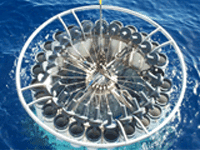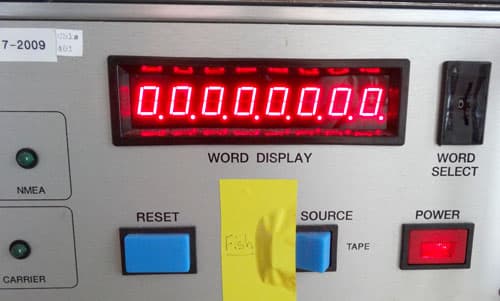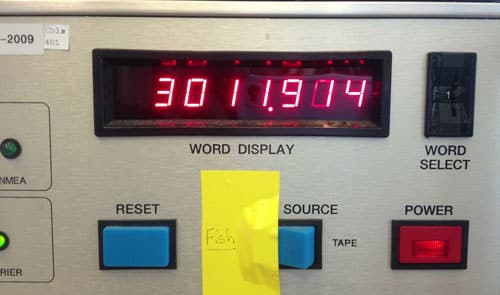Bottle Sampling Depths
- Post author:CalCOFI Technical Group
- Post published:8 Feb 2014
- Post category:Methods
- Post comments:0 Comments
Bottle Sampling Depths, based on downcast profiles
 The CalCOFI CTD-rosette is equipped with a Sea-Bird Electronic carousel water sampler (SBE 32), a computer-driven, electro-magnetically-released latch system. The 24 ten-liter plastic (PVC) bottles, equipped with epoxy-coated springs & Viton (non-toxic) O-rings, connect to 24 individual triggers by lanyards which keep the bottle ends open. During the downcast, profiles of different sensor measurements vs depth are displayed real-time on a computer screen. Based on the chlorophyll maximum & mixed layer depths, bottles are closed at specific depths to isolate the seawater. The 10 meter bottle spacing shifts up or down (see table below) to resolve steep gradient features such as chlorophyll, oxygen, nitrite maxima and shallow salinity minimum. Salinity, oxygen and nutrients samples are analyzed at-sea for all depths sampled. Chlorophyll-a and phaeopigments samples from the top 200 meters, bottom depth permitting, are also extracted for 24hrs and analyzed at-sea. Most CTD-rosette casts sample 20 depths to a maximum of 515 meters, bottom depth permitting. Occasionally, additional bottle depths or multiple bottles are tripped at the same depth to provide extra water for ancillary projects or primary productivity incubations. Two basin stations, off Santa Monica & Santa Barbara, are sampled beyond 515m to within 10m of bottom. Wire-length permitting, a 3500m deep cast is performed at sta 90.90.
The CalCOFI CTD-rosette is equipped with a Sea-Bird Electronic carousel water sampler (SBE 32), a computer-driven, electro-magnetically-released latch system. The 24 ten-liter plastic (PVC) bottles, equipped with epoxy-coated springs & Viton (non-toxic) O-rings, connect to 24 individual triggers by lanyards which keep the bottle ends open. During the downcast, profiles of different sensor measurements vs depth are displayed real-time on a computer screen. Based on the chlorophyll maximum & mixed layer depths, bottles are closed at specific depths to isolate the seawater. The 10 meter bottle spacing shifts up or down (see table below) to resolve steep gradient features such as chlorophyll, oxygen, nitrite maxima and shallow salinity minimum. Salinity, oxygen and nutrients samples are analyzed at-sea for all depths sampled. Chlorophyll-a and phaeopigments samples from the top 200 meters, bottom depth permitting, are also extracted for 24hrs and analyzed at-sea. Most CTD-rosette casts sample 20 depths to a maximum of 515 meters, bottom depth permitting. Occasionally, additional bottle depths or multiple bottles are tripped at the same depth to provide extra water for ancillary projects or primary productivity incubations. Two basin stations, off Santa Monica & Santa Barbara, are sampled beyond 515m to within 10m of bottom. Wire-length permitting, a 3500m deep cast is performed at sta 90.90.
 SIO-CalCOFI’s method of terminating the sea cable uses a custom
SIO-CalCOFI’s method of terminating the sea cable uses a custom  Once the sea cable is connected to the Seabird 9plus and Seabird 11plus deck unit, the deck unit can be powered on. If cabled properly and all electronics are functioning, the numeric LED panel of the deck unit should display non-zero numbers. These values are different for each channel which can be selected by rotating the WORD SELECT dial to the right of the LED panel.
Once the sea cable is connected to the Seabird 9plus and Seabird 11plus deck unit, the deck unit can be powered on. If cabled properly and all electronics are functioning, the numeric LED panel of the deck unit should display non-zero numbers. These values are different for each channel which can be selected by rotating the WORD SELECT dial to the right of the LED panel.